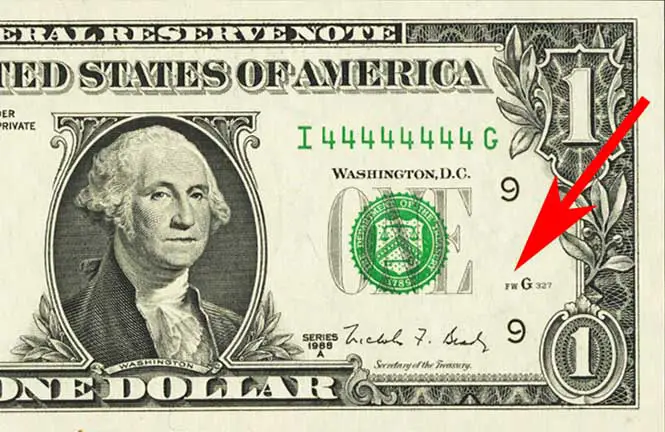- Home
- Federal Reserve Notes
United States Federal Reserve Notes
Federal Reserve Notes are more commonly known as US Dollars and are the paper currency that circulates around the United States of America.
The notes are printed by the The Bureau of Engraving and Printing for the twelve reserve bank districts to be distributed into general circulation.
All United States Federal Reserve Notes are either printed at Washington D.C. (Eastern Currency Facility) or Fort Worth, Texas (Western Currency Facility).
FRN's were conceived in a response to the fluctuating financial issues of different banking systems within the United States.
The Federal Reserve was established as the US's central bank in 1913 when the Federal Reserve Act was passed. This created a new national banking system.
1914 Large Series Bills

Image Courtesy of Wikipedia
The first two series of FRN's from 1914 and 1918 were larger than the the current series and measured approximately 7.375 inches x 3.125 inches. After 1928 the notes were reduced in size to approximately 6.14 inches x 2.61 inches.
The initial batch of the new FRN's were printed in 1914 and were available in the following denominations: $5, $10, $20, $50 & $100.
The $5 bill featured Abraham Lincoln, the $10 bill featured Andrew Jackson, the $20 bill featured Grover Cleveland, the $50 bill featured Ulysses S. Grant and the $100 bill featured Benjamin Franklin.
All notes were available with either a red or blue seal and signed by Frank White (Treasurer of the U.S.) and Andrew Mellon (Treasury Secretary).
In 1918 the Federal Reserve Board started issuing FRN's in higher denominations. These included $500, $1000, $5000 & $10000.
The $10000 with a blue seal and featuring Salmon P. Chase wasn't intended for public circulation, but instead for large bank to bank transfers.
The $500 bill featured John Marshall, the $1000 bill featured Alexander Hamilton and the $5000 bill featured James Madison.
All these notes had blue seals and were signed by John Burke (Treasurer of the United States) and Carter Glass (Secretary of the Treasury).

Image Courtesy of Wikipedia
1928 Series Small Bills
The 1928 series of new smaller dollar bills were created with new designs on the reverse.
They also had unique serial numbers added for the first time and a new green seal was used for all denominations.
The $5 bill features Abraham Lincoln on the obverse and the Lincoln Memorial on the reverse.
The $10 bill features Alexander Hamilton on the adverse and the Treasury department building on the reverse.
Andrew Jackson who used to feature on the old $10 bill is now on the obverse of the $20 bill with a picture of the White House on the reverse.

Image Courtesy of Heritage Auctions
The front of the $50 bill features Ulysses S Grant with an image of United States Capitol on the reverse and the $100 bill features Benjamin Franklin on the obverse with Independence Hall on the reverse.
The new 1928 series $500 bill was designed in 1945 and featured President William McKinley’s portrait, while the $1000 FRN had the obverse redesigned to feature Grover Cleveland.
The $5000 & $10000 bills stayed much the same except on the reverse it now reads the denomination written in this style: "Ten Thousand Dollars"
1934 Series Federal Reserve Notes
The obligation clause on the 1934 series of federal reserve notes changed to read, "This note is legal tender for all debts, public and private, and is redeemable in lawful money at the United States Treasury, or at any Federal Reserve Bank".
It used to read, "Redeemable in gold on demand at the United States Treasury, or in gold or lawful money at any Federal Reserve Bank".
The highest denomination was still $10,000 and the branch ID on all the notes changed from numerals to letters.
With the arrival of the Series 1934B, the black Federal Reserve Bank seals changed slightly with the removal of the word "The".
Instead of reading, "The Federal Reserve Bank of...(whatever city and state)", it now read "Federal Reserve Bank of...(whatever city and state)".
There were also some design changes introduced to the back of the $20.
These were introduced in 1948 and affected some of the 1934C and all the 1934D ranges.
The vignette of the White House was updated to reflect the changes made over the years including the maturing of the trees and shrubbery.
At the bottom of the image it now reads "The White House" as opposed to just "White House".
It also looks a bit more zoomed in and now includes a balcony with much bigger trees in the foreground.
1935 - Micro And Macro Plate Numbers
New macro sized plate numbers were introduced and printed on all FRN's going forward.
The previous plate number size was called micro.
As they were being changed over, front and back plates weren't always paired with like for like, resulting in "mules" being printed.
A mule was produced when a note had different sized number printing on each side.
One side had been printed with a micro plate number and the other side printed with a macro plate number.
1950 Series - Major Resign
Denominations included in the 1950 series of Federal Reserve Notes were $5, $10, $20, $50 & $100.
There were also design changes to the branch logo, note series, the placement of the signatures of the United States Treasurer and the Treasury Secretary.
The 1950 series also included Washington DC above the seal.
1963 Series
In 1963 the first $1 Federal Reserve note was produced and also the first ATMs started appearing in New York City.
These allowed customers to get cash from their accounts without needing to visit the bank.

Image Courtesy of Heritage Auctions
The 1963 series $1 FRN features George Washington on the obverse and the great seal of the United States on the reverse.
This $1 bill has a green treasury seal and is signed by the US Treasurer Katherine O'Hara Granahan and the Treasury Secretary C Douglas Dillon.
The obligation clause also changed for the 1963 series FRN to "This note is legal tender for all debts, public and private".
At the bottom of all 1963 series FRN's the words "Will pay to the bearer on demand" were removed going forward.
1969
The Latin seal was replaced by an English seal.
End of large denomination bills, $500, $1000, $5000, $10000
1976 Series
As a cost saving measure by the Secretary of the Treasury William E. Simon, the new $2 Federal Reserve Note is introduced.
It was designed to commemorate the bicentennial and also the 233rd anniversary of Thomas Jefferson's birth.
The obverse of the 1976 2 dollar bill features the portrait of Jefferson, while the reverse has an image depicting the signing of the Declaration of Independence.
1977 Series
1981 Series
1985 Series
Federal Reserve Note denominations included in the 1985 Series are $1, $5, $10, $20, $50 & $100.
The main changes for this series are the signatures of Katherine D. Ortega and James A. Baker.
1988 & 1988A Series
There were two series produced for 1988. The 1988 Series included denominations of $1, $5, $50 & $100 and were signed by Katherine D. Ortega and Nicholas F Brady.
The 1988A Series denominations were $1, $5, $10 & $20 and were signed by Catalina Vásquez Villalpando and Nicholas F Brady.
Some of the 1988A $1 and $5 bills were printed in Fort Worth TX from March 1991 onwards.
Fort Worth was the BEP's new Western Currency Facility which started printing at the start of 1991.

Image Courtesy of Heritage Auctions
You can identify notes printed at this facility by the 'FW' on the far right of the bill obverse beside the face plate number.
1990 Series
Some new security features were added to 1990 series FRN's which included micro printing and a plastic security strip to the left of the Grant portrait.
The $10, $20, $50 and $100 bills were updated during the 1990 series and the $5 was updated during the 1993 series. The $1 and $2 didn't change as they weren't widely targeted by counterfeiters.
